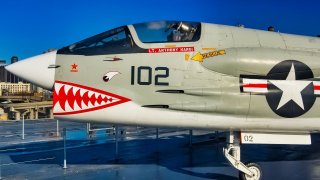F-8 Crusader: Why This Navy Warplane Was Called the Last of the Gunfighters
The F-8 Crusader was hard to fly. With a high sink rate, the jet was difficult to guide safely onto the deck of a pitching aircraft carrier. And the castering nose undercarriage was quite difficult to steer on deck. The aircraft’s accident rate was so high that it earned the nickname “ensign eliminator.”
Vought F-8 was a Cold War fighter like no other and served the Navy well in many instances.
Of all the equipment in the U.S. military’s inventory, the Vought F-8 Crusader had perhaps the most romantic nickname: “The Last of the Gunfighters.”
As you may have figured, the F-8 was the last U.S. fighter to feature guns as the primary weapon.
Still, the F-8 and its mid-century gun-prioritizing configuration served in the U.S. Navy until 1976.
F-8: The Making of the Last Gunfighter
In 1952, the U.S. Navy announced a set of requirements for a new fighter aircraft. The new jet was to have a top speed of Mach 1.2 with a climb rate of 25,000 feet per minute. However, despite being able to break the sound barrier, the new jet needed to land at speeds not exceeding 100 miles per hour.
Vought set about designing a jet to meet the Navy’s requirements, hoping to win the contract.
Vought came up with the F-8 Crusader, which was odd in that it featured high-mounted wings, set atop the fuselage. The new jet was built around a single Pratt & Whitney J57 turbojet engine. Operating dry (without afterburners), the engine provided 10,200 pounds of thrust. With afterburners engaged, the J57 offered 16,000 pounds of thrust. First flown in 1955, the F-8 was the first U.S. jet to reach 1,000 miles per hour.
The F-8 Crusader Had Defining Features
The Crusader featured a variable-incidence wing, which was quite innovative at the time. The variable-incidence wing was capable of pivoting seven degrees out from the fuselage on takeoff and landing, which allowed the jet to achieve a greater angle of attack and increased lift. The new wing design was celebrated; Vought’s design team won the Collier Trophy, awarded to those who make “the greatest achievement in aeronautics or astronautics in America, with respect to improving the performance, efficiency, and safety of air or space vehicles, the value of which has been thoroughly demonstrated by actual use during the preceding year,” in 1956. Note: the variable-incidence wing should not be confused with the variable-sweep wing, which features a larger range of motion, found on jets like the F-111 Aardvark and F-14 Tomcat.
Despite being designed around four 20mm autocannons (and earning the romantic nickname), the Crusader also featured a retractable tray of 32 unguided Mk 4/Mk 40 Folding-Fin Aerial Rockets, plus cheek pylons with two guided AIM-9 Sidewinder air-to-air missiles.
Ironically, the 20mm guns on “The Last Gunfighter” were mostly unreliable – they had a tendency to jam under G-loading. G-loading, of course, happened regularly when the guns were most needed: dogfights. With a shoddy loading mechanism, the 20mm cannon only earned four air-to-air victories; the majority of the F-8’s air-to-air kills were achieved using Sidewinder missiles.
The F-8 Crusader was hard to fly. With a high sink rate, the jet was difficult to guide safely onto the deck of a pitching aircraft carrier. And the castering nose undercarriage was quite difficult to steer on deck. The aircraft’s accident rate was so high that it earned the nickname “ensign eliminator.”
Of the 1,261 Crusaders that were built over the jet’s production run, a stunning 1,106 were involved in mishaps.
Still, the F-8 had its moments. During the Vietnam War, Crusader pilots claimed the best kill ratio (19:3) of any U.S. aircraft. Crusader pilots, proud of their aircraft and proud of their performance, wore an insignia stating: “When You’re Out of F-8s You’re Out Of Fighters.”
About the Author: Harrison Kass
Harrison Kass is a defense writer with over 1,000 articles published. An attorney, pilot, guitarist, and minor pro hockey player, he joined the US Air Force as a Pilot Trainee but was medically discharged. Harrison has degrees from Lake Forest College, the University of Oregon, and New York University. He lives in Oregon and listens to Dokken. Follow him on Twitter @harrison_kass.
All images are Shutterstock.


